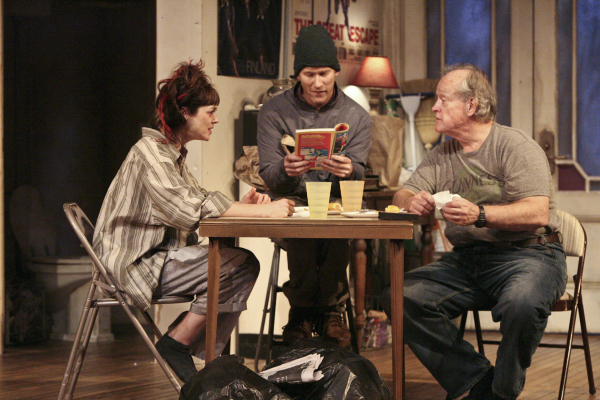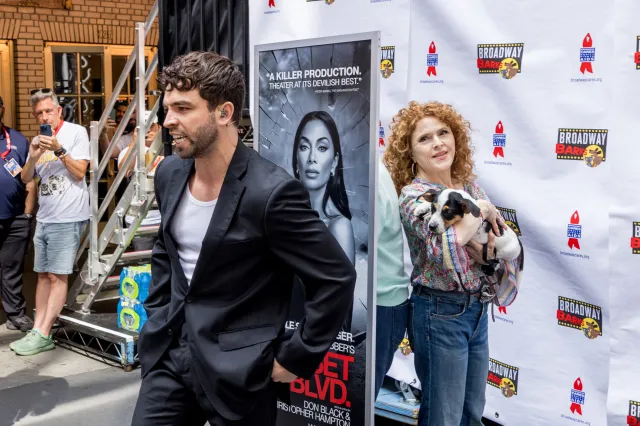The Night Alive
This award-winning play by Conor McPherson has its West Coast premiere at the Geffen Playhouse.

(© Michael Lamont)
Following a fruitful run dazzling his audiences with works both ghostly and cerebral, the playwright Conor McPherson has taken a significant step away from the well-spun yarn. The polarizing ambiguity of his play The Night Alive — now having its West Coast premiere at the Geffen Playhouse — is enough to leave viewers simply scratching their heads, despite a charismatic and well-synched cast working under the guidance of Geffen Artistic Director Randall Arney.
Set in present-day Dublin and focusing on a parcel of hardscrabble characters who collect strange objects and stash their money in boxes under the floorboards, The Night Alive purports to be a tale of love and possible redemption. Arney and his cast members — Paul Vincent O'Connor, Denis Arndt, Dan Donohue, Peter O'Meara, and Fiona O'Shaughnessy —feed into rather than chafe against the play's moody weirdness. Their journey, such as it is, is a rocky one.
A man steals into a room, surveys its dishevelment with acute disdain, carefully folds a towel, and then gives up and departs. He's the landlord. Into the same room via a side entrance comes Tommy (O'Connor) ushering a much younger woman, Aimee (O'Shaughnessy), who has been attacked and is doing her best to staunch her bleeding nose. Tommy lets the room from his uncle Maurice (Arndt) and given the exquisite messiness (as designed by Takeshi Kata), it's a safe bet Tommy has not entertained a visitor since 1972.
An unlikely hero and Good Samaritan, Tommy makes his living with odd jobs and deliveries, driving a van with his coworker and friend Doc (Donohue), who often crashes on Tommy's cot. That arrangement won't be possible now that Aimee will be staying with Tommy for the foreseeable future. Aimee has a shadowy past and the arrival of yet another stranger Kenneth (O'Meara) makes the picture even murkier.
Where all this is heading is not easy to tell. The relationship between Tommy and Maurice (who, we later learn, essentially raised Tommy) is complicated, but it starts to become more clear the more booze Arndt's Maurice pours down his gullet. The Tommy-Doc dynamics are equally touchy, with Tommy being perfectly willing to take advantage of his slow-witted friend or to discard him.
O'Connor, sloppy and vaguely bearlike, turns in excellent work as the lovestruck Tommy who might be caught up in something far beyond his control. His interplay with O'Shaughnessy's Aimee is handled with real delicacy, a gradual transition from protector to something deeper. The two of them cutting loose to Marvin Gaye – with Doc reluctantly joining in – is a highlight of the show. Playing characters even more damaged than Tommy, Arndt and Donohue are both quietly effective as well as opposing millstones on Tommy's conscience.
"What's Going On?" warbles Mr. Gaye during the aforementioned scene between Tommy and Aimee, and audiences at The Night Alive may well ask the same question. There may be a point where McPherson's play unmoors from reality and perhaps enters the subconscious of one of its characters. Or maybe not. As we approach the finish of this quizzical 100-minute play, Doc recites a detailed monologue about the function of black holes – a set of facts that this character could not possibly have committed to memory. Shortly thereafter, as the curtain falls, we get an even more ambiguous image, aided in no small measure by a lighting effect from designer Daniel Ionazzi.
That life, and even afterlife, is complicated and confusing, we already know. Still, even the card players in McPherson's The Seafarer knew how things stood once the dealing was done. Not so much here. As magical a journey as it often is, Arney's production leads us more so into confusion than anywhere else.








